
gold forms in Type II supernova explosions, such as the one that formed the Crab Nebula
Source: NASA Goddard Space Flight Center, Flickr

gold forms in Type II supernova explosions, such as the one that formed the Crab Nebula
Source: NASA Goddard Space Flight Center, Flickr
Nucleosynthesis of gold starts with atoms of iron which were formed by fusion within the core of a star. All elements in the universe with more than 26 protons in their nucleus (i.e., "heavier" than iron) were created through neutron capture processes, when neutrons are forced into the nucleus of an atom within a star.
In the subsequent radioactive decay process, a beta particle (electron/positron) is emitted from that neutron. The neutron is converted into a proton by that beta decay, and an atom of an element with one higher atomic number is formed.
Nearly all gold atoms were created very quickly in what physicists called the r-process, for with "r" for "rapid" nucleosynthesis. It is possible that some gold atoms formed in the s-process ("s" for "slow"), just before an old star becomes a white dwarf. It is also possible that super-heavy unstable elements with more than 260 protons in their nucleus formed in massive stars during the first five billion years of the universe, and then through rapid fission created stable elements now found in the Periodic Table with less than 120 protons.
Assuming the atoms of gold found in Virginia today were formed originally by the rapid nucleosynthesis process, then Virginia's gold deposits started when a single star's nickel-iron core collapsed to create a Type II supernova, through the collision of two neutron stars to create a kilonova, or when an extreme magnetic field disrupted a neutron star. Three separate processes could have produced the gold atoms, but there is still some mystery. Astronomers have not identified enough events that would have compressed protons and neutrons to create the total amount of gold thought to exist in the universe. Either more events occurred, or another mechanism is yet to be discovered.
A supernova is a high-energy explosion of a fast-spinning star with a strong magnetic field. In the initial pressure cooker phase, the collapse of a star's core compresses atomic particles together faster than radioactive decay splits the nuclei apart. The intense pressure forces a proton into a nucleus, creating a new element. Almost immediately, in the second phase, a violent explosion expels the newly-formed elements into a gaseous cloud.
In a kilnova, neutron star mergers within 1,000 light-years of our solar system could have created a high percentage of the heavy elements that coalesced and formed Earth and the other planets in our solar system. A merger of two neutron stars could create 13,170,000,000,000,000,000,000,000 (13 septillion) pounds of gold - or even 13 times that total.
Perhaps 80 million years before the formation of our solar system 4.6 billion years ago, one or more kilonova or Type II supernova events disseminated gold and other heavier-than-iron elements atoms as a gas into space. Those elements then cooled into dust particles, drifting with hydrogen and helium in interstellar gas clouds. Gravitational forces triggered consolidation of dust and gas within a gas cloud.
The resulting spinning disk gradually morphed into our Solar System, with a new star in the center. Though more than 98% of the interstellar gas cloud was hydrogen and helium that ended up primarily in the sun, there were enough dust particles of other elements to form Mercury, Venus, Earth, and Mars plus the rocky cores of other planets. Heavy elements also consolidated to create the asteroids now orbiting between Mars and Jupiter, and were incorporated with frozen ices in the comets orbiting in the Kuiper Belt beyond Uranus. Gold atoms were scattered within all of them, not just on Earth.
all gold on earth came from outer space, and the gold atoms may have formed when two neutron stars collided
Source: National Aeronautics and Space Administration (NASA), Doomed Neutron Stars Create Blast of Light and Gravitational Waves
Despite the dreams of medieval alchemists who sought to transform lead into gold, nearly all of the gold atoms on earth are older that the formation of the earth itself; gold on earth originally came from outer space.
In contrast, the diamonds found on Earth were created on this planet. It is likely that most of the carbon atoms within diamonds are ancient and pre-date the formation of earth, just like the gold atoms. However, those carbon atoms were not aligned to create diamond crystals that drifted as dust particles within the interstellar cloud 4.6 billion years ago. Instead, after the Earth formed, intense pressures within the mantle aligned carbon atoms into the crystal form of diamonds.
The process for creating heavier-than-iron atoms, including gold, is not 100% settled by scientists yet. A 2020 scientific study concluded that the frequency of neutron star collisions leading to a kilonova was too low to create all the gold identified today. In addition to star collisions and Type II supernovae, magnetorotational supernovae could have forced protons into nuclei to create the elements beyond gold in the Periodic Table of Elements.1
When the earth originally cooled to form a planet 4.6 billion years ago, the initial gold from the gas cloud sank into the core along with iron, nickel, and other heavy elements. During the Large Heavy Bombardment 500 years later, meteorites contributed a new supply of gold, a "late veneer" that was incorporated into the crust at the surface. Today the metallic part of meteorites (from the core of failed planets) contains 1.4 parts per million (ppm) of gold, while the silicate portion (from the crust) contains 0.16 ppm. On average, gold in Earth's crust averages just 0.004 ppm.
Over the last 4.6 billion years gold atoms have been concentrated at different spots within the crust to create "ore," the rock from which it is economic to separate the valued metal from the waste "gangue" material. In the United States now, gold must reach a concentration of 1 ppm (1 gram/metric ton) to justify the investment required for mining.
In all of the Earth's crust there are approximately 400 billion kilograms of gold, of which less than 1% has been mined. Gold is dissolved in seawater, and technically can be extracted from the Atlantic Ocean at the edge of Virginia. At the very low concentrations of just 65 milligrams of gold per ton of seawater, however, such extraction would cost more than the value of the gold that could be isolated from the water and other dissolved elements.
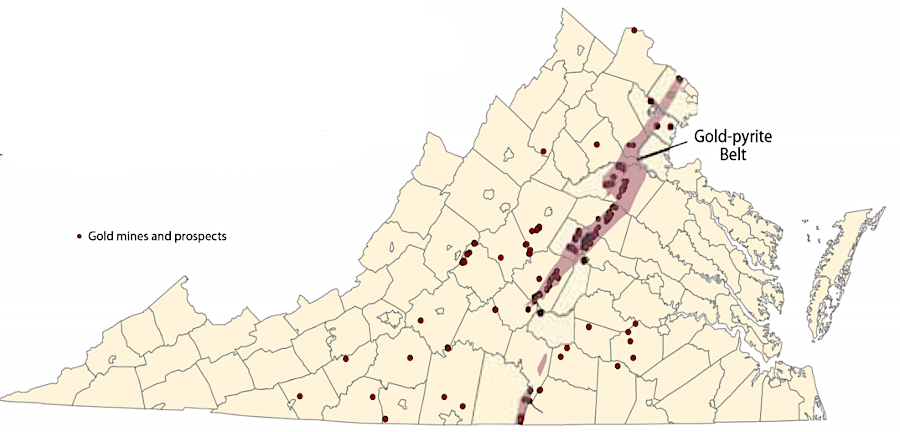
gold in Virginia is concentrated north of the James River in a gold-pyrite belt of metamorphic and volcanic rocks along the western edge of the Chopawamsic Terrane
Source: Virginia Department of Energy, Gold
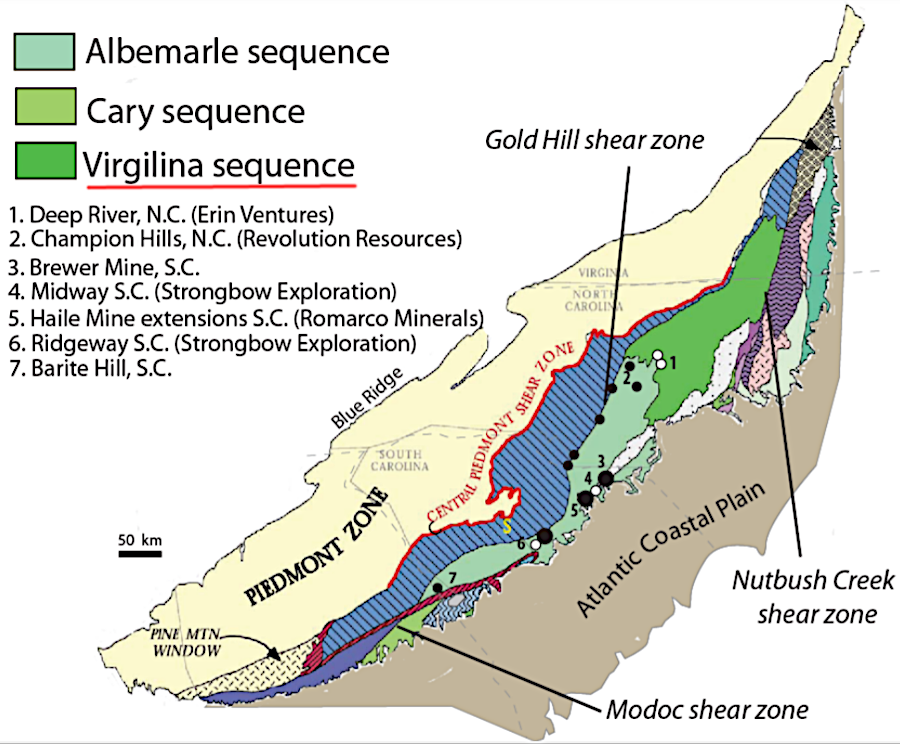
gold deposits in Virginia south of the James River are most common in the Virgilina District
Source: US Geological Survey (USGS), Gold Deposits of the Carolina Slate Belt, Southeastern United States: Age and Origin of the Major Gold Producers
The gold found in Virginia can be traced back to the time when volcanic island arcs formed in the Iapetus Ocean, on the edge of Laurentia and Gondwana. Hot and ductile magma rose from the mantle, creating massive sulfide deposits on the ocean floor with a relatively high percentage of iron and sulfur and a low percentage of gold. In the massive sulfide deposits, very hot fluids from the magma cooled as they reached sea water. That cooling triggered the deposition of silica and base metals (such as iron and copper) in vents and seeps on the seafloor. The process continues today at the Mid-Atlantic Ridge.
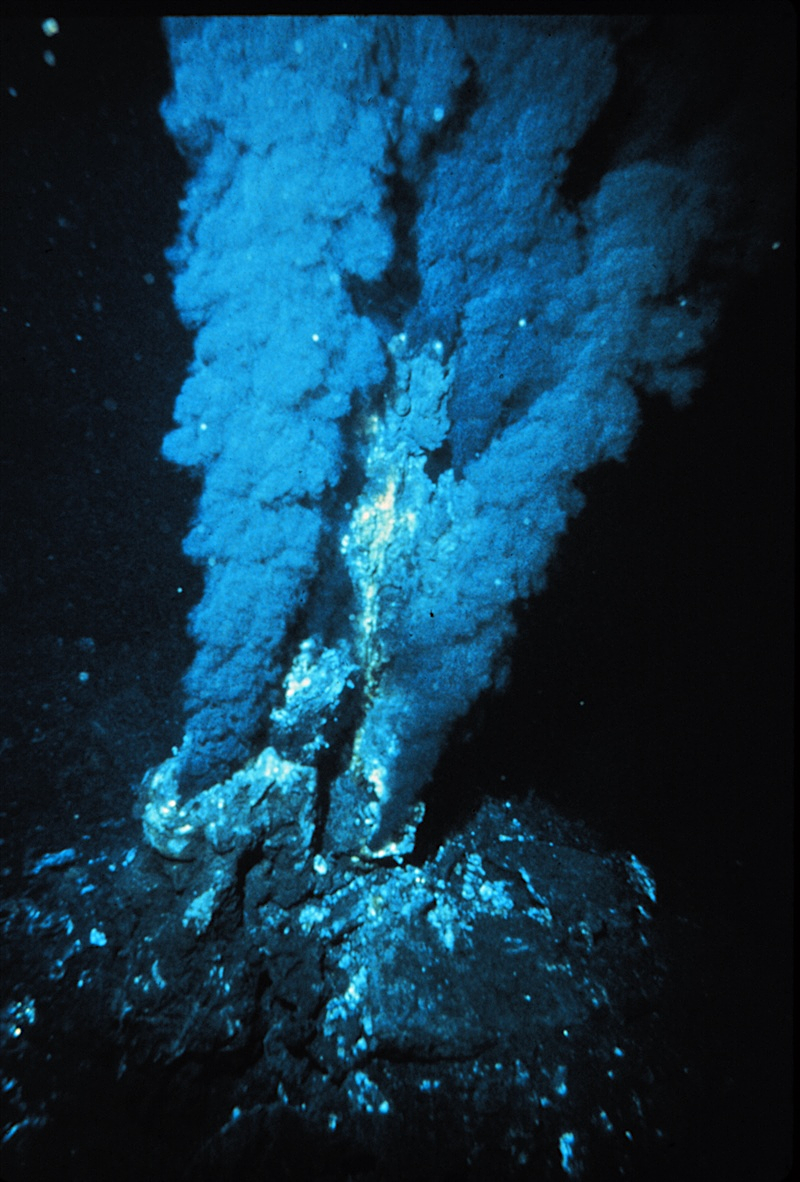
hydrothermal fluids at the edges of rifting ocean crust create massive sulfide deposits with gold
Source: National Oceanic and Atmospheric Administration (NOAA), Black smoker at a mid-ocean ridge hydrothermal vent
Different periods of mantle extrusion over the last 4.6 billion years have created different "chunks" of continental crust, including island arcs. During subduction, fluids containing the trisulfur ion rise up from the melting plate 30-50 miles deep. Gold in the overlying mantle combines to form a gold-trisulfur complex, Au(HS)S3–. Magma brings the mobile fluid that has concentrated the gold to the surface, where it cools in the conduits of volcanoes and forms ore deposits.
In the Tectonic and Neo-Acadian orogenies, tectonic forces pressed island arcs in the Iapetus Ocean together and accreted them as different terranes on the edge of Laurentia. That process first brought "syngenetic" gold in the original massive sulfide deposits to Virginia about 450 million years ago.
The collision with Gondwana (Africa and South America) 250 million years ago formed Pangea in the Alleghenian orogeny. That final mountain building episode broke off the "eastern" edge of Laurentia and thrust it westward up to 100 miles on top of other crust, creating the original Appalachian Mountains.
The collisions and thrusting bent sedimentary and igneous rock formations into synclines and anticlines. Pressures exceeded the competency of rock formations, breaking them apart and thrusting sheets of bedrock on top of other layers.
Heat and pressure created different levels of metamorphism, altering the minerals in the original bedrock formations. Massive sulfide deposits were reheated; silica, pyrite, and syngenetic gold in old channels that had fed black smokers was remelted. Hot (500–550 °C) hydrothermal fluids with molten quartz, pyrite and gold oozed from the massive sulfide deposits in metamorphic rocks into the faults during earthquakes as terranes collided and moved. As temperature-pressure decreased and those fluids cooled, "orogenic" gold deposits were formed.
Those hydrothermal fluids were squeezed into the existing bedrock. there were no open cracks in the bedrock at such depth. Silica, pyrite and gold slowly cooled into quartz lenses forming "pods" of gold ore. There were also multiple branches of quartz-gold veins extending away from the original massive sulfide deposits. Hydrothermal fluids with a higher percentage of pyrite cooled to form larger deposits of ore, rather than just small lenses, that were rich in iron and sulfur.
Gold deposits were formed as early cratons of continental crust collided in the Late Archean about 2.7–2.4 billion years ago, and again 2.1–1.8 billion years ago. There were fewer mountain building collisions in the Mesoproterozoic through Neoproterozoic, 1.6 billion–570 million years ago. In the last 650 million years, increased ocean oxygenation helped dissolve gold trapped in pyrite-rich deposits. "Old gold" was mobilized and concentrated by melting and recrystallization during the formation of Pangea, and all of Virginia's gold deposits were emplaced by the time of the Alleghenian orogeny around 300 million years ago.
The origin of Virginia gold deposits affect environmental impacts during mining. When veins with small amounts of pyrite are excavated, the waste rock generates little acid runoff. When massive sulfide deposits are excavated, low pH drainage from waste material can continue to damage streams for over a century. In Prince William Forest Park, there was minimal impact from the Greenwood Mine which excavated in gold vein deposits. The nearby Cabin Branch Mine, dug into a massive sulfide deposit, created significant acid and heavy metal pollution of Quantico Creek.

Piedmont gold is concentrated in small lenses and veins, where hydrothermal fluids cooled within metamorphic bedrock
Source: National Academies of Sciences, Engineering, and Medicine, The Potential Impacts of Gold Mining in Virginia (Figures 2-6 and 2-7)
When gold deposits crystallized as terranes collided, they were buried five or more miles deep beneath the surface. The gold was originally at the base of island arcs within the Iapetus Ocean, primarily the Ordovician-age Chopawamsic Terrane and the older Carolina Terrane. Later those chunks of crust were pressed against Laurentia in different orogenies as the supercontinent Pangea formed.
Over the last 300 million years since Pangea formed, erosion has removed the original surfaces of those terranes. That erosion has exposed the once-buried massive sulfide deposits and the associated faults with low sulfide gold-quartz vein deposits.
In the formation of Pangea, subduction of crust led to melting and differentiation of different minerals. The gold in today's Piedmont bedrock was probably remobilized roughly 450-250 million years ago, between the Taconic and Alleghenian orogenies. The accretion of the Potomac Terrane which had formed between 500-470 million years ago, followed by the younger Chopawamsic Terrane which had formed between 474-465 million years ago, heated the massive sulfide deposits. The hydrothermal fluids flowed again, and their cooling determined where gold was ultimately deposited within Virginia.
Gold found in the Virgilina District, south of the James River, formed in the Carolina Terrane (Carolina Slate Belt). Some of the original concentration of gold in the Virgilina District occurred about 650 million years ago as the island arc was first created, There appears to have been a major influx of gold mineralization 550 million years ago.
The Gold-Pyrite Belt in the Piedmont physiographic province is a zone of mineralization 15-25 miles wide, east of the Blue Ridge and stretching 175 miles south of the Potomac River, which includes both the Western Potomac and the Chopawamsic terranes. Gold deposits north of the James River probably formed 550 million years ago.
During original formation or later in the orogenies:2
Gold and quartz melted at similar temperatures. Under heat and pressure, they replaced minerals within fractures that formed parallel to thrust faults. As the mass of molten rock slowly cooled below 1,943°F, gold molecules shifted from a liquid to a solid state and "froze" or crystallized in place.
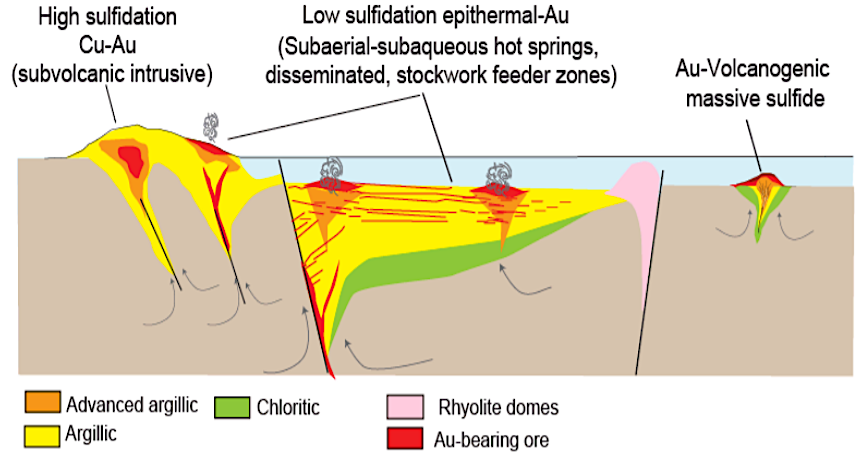
gold deposits formed originally when minerals in magma melted and crystallized at different temperatures, concentrating gold with quartz and sulfides
Source: US Geological Survey (USGS), Gold Deposits of the Carolina Slate Belt, Southeastern United States: Age and Origin of the Major Gold Producers
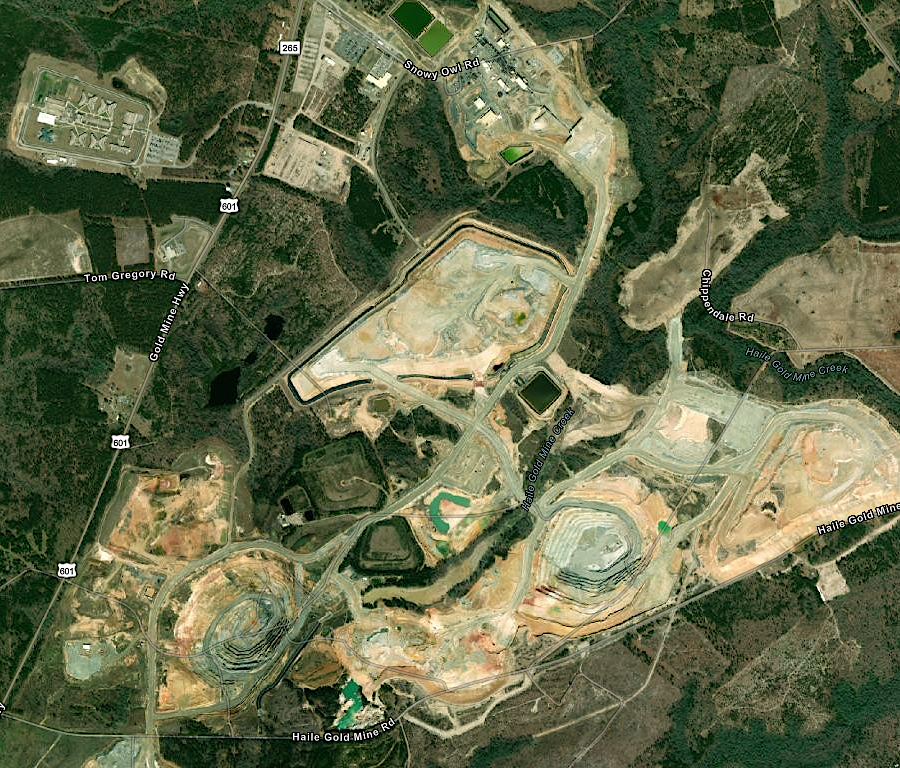
open pit mining of the Haile gold deposit in South Carolina resembles excavation at a rock quarry
Source: ESRI, ArcGIS Online
The origin of gold deposits in Virginia remains unclear. Some may be syngenetic, others orogenetic.
Geologists studying the Carolina Slate Belt deposits concluded that gold deposition occurred over several hundred thousand years. Some deposits formed within 50,000 years, where the magma source cooled without renewal from the heat source. There were different ore-forming environments for each deposit, and:3
Some veins may be even younger than the Alleghenian orogeny and date from the time when Pangea split up about 225 million years ago. Triassic basins developed when the crust thinned. Earthquakes were a common occurrence as blocks of crust moved at faults moved. The sediments in the basins tilted and molten basalt at great depth jetted through cracks to the surface. When the pressure of the overlying rock was released briefly during earthquakes, other fluids may also have boiled up towards the surface, squeezing through cracks in the surrounding rock.
When silica cooled back into hard rock, it formed new quartz veins within the fractures through which the liquid had moved. At the Vaucluse Mine in Orange County, gold was found mixed with "rose" quartz (colored by iron oxide) and sericite (white mica) formed when feldspars were altered by hydrothermal fluids.
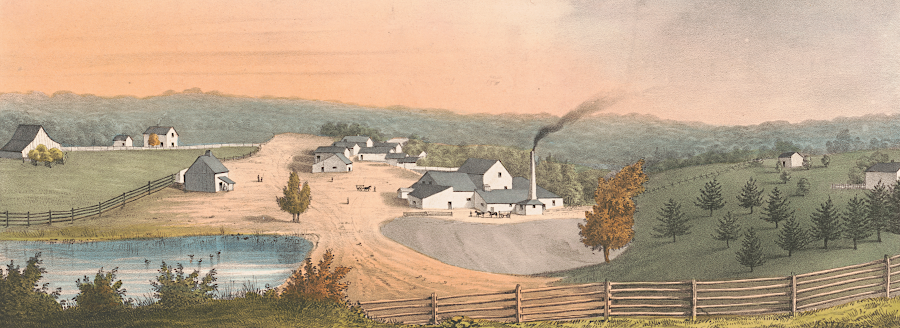
in 1832 gold was discovered at Vaucluse in Orange County, and mining continued until 1938
Source: Library of Congress, Vaucluse Goldmine
In those locations where gold had been a component of the molten fluids at depth, those quartz veins included gold deposits. Sulfur was also common in those hydrothermal fluids, so crystals of pyrite - iron sulfide (FeS2) - are also found along with gold ore. The glint of iron sulfide crystals has led to its common name, "fool's gold."
The gold may have been carried in the hydrothermal liquid as nanoparticles that formed a colloid, comparable to how proteins and fats are suspended within milk. When the high concentration of suspended gold nanoparticles finally crystallized as the hydrothermal liquid cooled, thick gold veins were created.
Some gold was simply dissolved in hot fluids, rather than suspended in a colloid. The tiny particles which crystallized would create very thin layers of gold in Virginia, rather than the thick veins with nuggets cherished by gold prospectors. Recent research suggests that nuggets may be created during earthquakes when quartz crystals are squeezed repeatedly. Quartz is a piezoelectric mineral that triggers electrical currents when pressure changes. Gold nanoparticles are deposited from the very dilute fluid during each "sqeeze," accumulating into nuggets.
Tiny particles can be extracted commercially today, especially from volcanic deposits where gold literally erupted as a tiny percentage of the material in ash clouds. The ash is heaped into a pile, and then a fluid with cyanide is poured on top. As the fluid flows through the heap, gold dissolves into it. The final step is extracting the gold from the "pregnant liquor," after which the cyanide can be reused.
Worldwide production of gold increased significantly after World War II. In 2024, China was the largest producer of gold, though demand was so high that China still imported about three times as much as it produced:4
Gold atoms have cycled and been recycled into different locations over time. As gold crystallized within bedrock while still buried miles underground, some vaporized gold may have been emitted from volcanoes as fine particles with volcanic ash. As terranes were accreted to the edge of the North American Plate, any such finely disseminated gold could have accumulated in small placer deposits while subsurface gold near hot springs was concentrated into ore bodies.
Under heat and pressure during the Taconic, Neo-Acadian, and Alleghenian orogenies, orogenic gold was squeezed along with silica (quartz) into the lenses and veins now scattered within the metamorphosed bedrock of the Virginia Piedmont. Erosion has now exposed that gold at the surface, and it has washed downstream along with particles of quartz, feldspar, and other minerals from the metamorphic bedrock.
Since gold atoms are relatively heavy, they have accumulated in placer deposits. The first gold mines in Virginia started in those placer deposits.
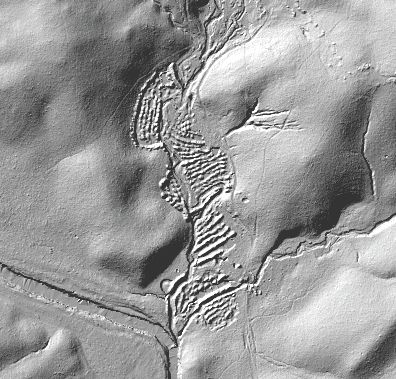
rocks piled in rows show the site of the Bertha and Edith placer gold mine (Goochland County)
Source: Virginia Department of Energy, LIDAR
Underneath placer deposits at the surface, or upstream, are funnel-shaped feeder zones of veins with gold ore. Low-grade gold deposits at the surface identify where exploration geologists are likely to discover high-grade feeder zones. Deep drilling can identify if there is sufficient gold-rich ore at depth to justify the expense of creating an open-pit mine in Virginia, similar to the Haile mine in South Carolina, or even underground mining shafts in the richest ore bodies.
The earliest English settlers of the Virginia Company were looking for gold. Gold equals wealth to humans on multiple continents. At one time the richest man in the history of the world was the ruler of Mali, a man named Mansa Musa. In the early 1300's he controlled more wealth than any other human who has ever lived, because Mali produced most of Africa's gold. Mali was the major source of gold for Europe until the discovery of the New World, and Mansa Musa made Timbuktu a center of education and culture.
He made a 3,500 mile pilgrimage to Mecca in 1324. He distributed large amounts of gold on the trip, causing an economic shift around Cairo by dramatically increasing the supply of the precious metal during his stay there. The portolan chart produced by Angelino Dalorto in 1325 and the Catalan Atlas produced in 1375 prominently display him on a golden throne at Timbuktu.5

control of gold made Mansa Musa, ruler of Mali, the richest human in the world
Source: Wikipedia, Catalan Atlas
The Spanish seized vast amounts of gold from Aztec, Inca, and other Native American societies in Central and South America. The English started their colonization efforts about a century later, and targeted North America to avoid conflict with existing Spanish settlements. In Virginia and then later colonies, the English did not discover any native societies in North America that had mined and accumulated gold. The gold discovered by the English within Native American communities along the East Coast had been acquired from shipwrecks or exchange with early Spanish and French settlers.
The first gold rush in the United States occurred in North Carolina nearly two centuries after Jamestown was settled. In 1799, a 12-year old boy found a heavy rock with a yellow color near the site of modern Charlotte. The family used it as a doorstop until 1802, when a North Carolina jeweler bought the rock for $3.50. After he revealed the doorstop was a 17 pound gold nugget, the gold rush began in the western North Carolina Piedmont. Initial mining depleted placer deposits where gold had accumulated in streambeds. In 1825, miners began digging in the ground to extract gold from lode deposits, where it was mixed with quartz in veins.6
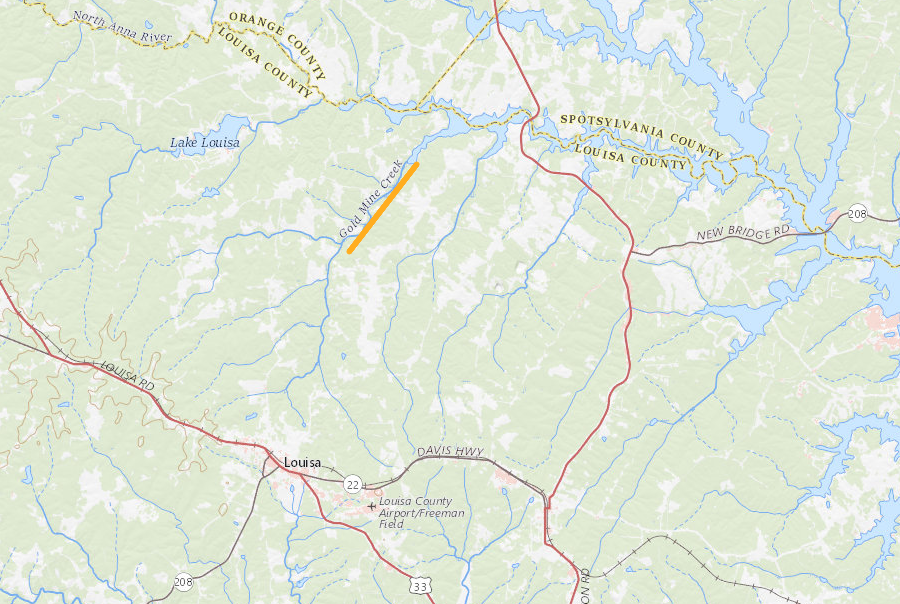
Gold Mine Creek now flows into Lake Anna
Source: ESRI, ArcGIS Online
Thomas Jefferson documented the first gold discovered within Virginia:7
That lump of ore must have washed down from its original location in the Piedmont, past the Fall Line at Fredericksburg, before settling with other sediments in a placer deposit on the Coastal Plain. Jefferson's handwritten version of Notes on the State of Virginia suggests he had heard of gold in the Piedmont physiographic province, but he edited out information about Gold Mine Creek before publication.
Jefferson's report may be completely bogus. He claimed a lump of ore weighing about four pounds yielded seventeen penny-weight of gold, or 26.4 grams (almost one ounce). Ore with nearly seven grams of gold per pound, or 14,000 g/t (grams per metric ton), would be richer than any deposit ever discovered in Virginia. Since gold mining began:8

Thomas Jefferson may have been aware of gold in Louisa County, as well as a nugget found downstream of Fredericksburg
Source: Massachusetts Historical Society, Notes on the State of Virginia (p.14)

Jefferson claimed a lump of ore contained 14,000 g/t (grams per metric ton), which is unlikely when compared to known deposits in Virginia
Source: National Academies of Sciences, Engineering, and Medicine, The Potential Impacts of Gold Mining in Virginia (Table 2-1)
Despite the dreams of the Virginia Company in 1606 and 17th Century colonists, gold had to be brought to Virginia. In the colonial era, coins of gold and silver were scarce. There was so little "hard" money (gold or silver) that Virginians used tobacco receipts as a form of cash.
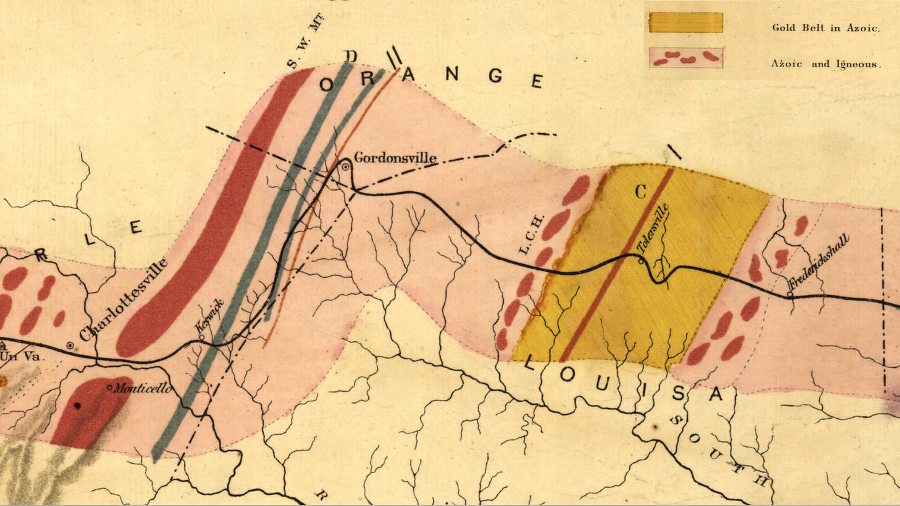
the Chesapeake and Ohio Railroad identified where gold might be mined along its route in the Piedmont
Source: Library of Congress, Map showing the economic minerals along the route of the Chesapeake & Ohio Rail Way (Thomas S. Ridgway, 1872)
Various legends claim that General Braddock brought a chest filled with gold in 1755 to Alexandria before he marched to capture Fort Duquesne from the French. In one legend, the gold was buried along what is known today as Braddock Road near Centreville in Fairfax County, before Braddock's military operation got far from Alexandria on its way to disastrous defeat in Pennsylvania. The coins intended to be used for paying the soldiers were melted and poured into cannon barrels, then buried to lighted the load and prevent wagons from getting stuck in the mud.
Other legends suggest the gold was buried during the hurried return after the defeat on the Monongahela River. To date, treasure hunters have found nothing, and historians debunk the claims that a buried treasure even exists. Claims about the Beale Treasure, and gold of the Confederate Treasury carried to Danville by train as President Jefferson Davis and other officials fled Richmond in April 1865, have also generated unsuccessful treasure hunts.9
The first searches for gold involved looking for tiny flakes in streams. East of the Fall Line, bottoms of the rivers were covered with silt and mud that totally obscured any evidence of gold flakes. Coastal Plain streams eroded through sediments with no gold ore, so Native Americans had no local sources and English colonists had no luck finding placer gold deposits.
The first placer miners that looked in streambeds west of the Fall Line scooped up gravel and sediments in a bowl filled with water. Larger pieces of gravel and cobbles were picked out, then the remaining sediments were swished in the bowl. Lighter particles washed over the edge, while flakes of the heavier gold particles (twice as heavy as lead) accumulated at the bottom of the bowl. Flakes of gold had been accumulating for thousands of years at the bottom of Virginia's streams before placer miners arrived, but it did not take long to exhaust the accumulated supply.
To find more gold required finding ore in the bedrock, and excavating ore at those sites from which flakes were eroding into the streams. Virginia had no sites east of the Fall Line where gold ore was exposed at the surface. Only after gold-seeking settlers moved west of the Fall Line was it possible to discover lodes of ore where gold was concentrated enough to be worth mining.
The first commercial gold mining in Virginia started in 1804 at Whitehall Mine near Shady Grove Church in Spotsylvania County. It was in the Chopawamsic Terrane, that island arc accreted to the North American tectonic plate in the Ordovician Period. The veins of quartz and gold had melted/crystalized at similar temperatures. Hydrothermal fluids migrated through other layers of rock during metamorphism, and when the liquids cooled the gold and silica quartz) crystalized in veins. Miners at Whitehall dug at least one shaft 100 feet deep.10
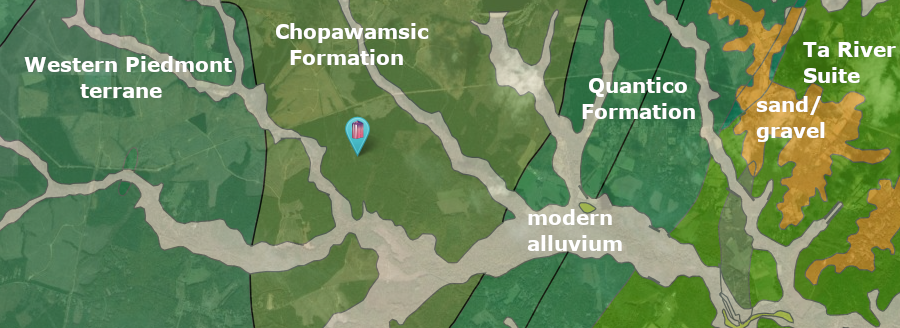
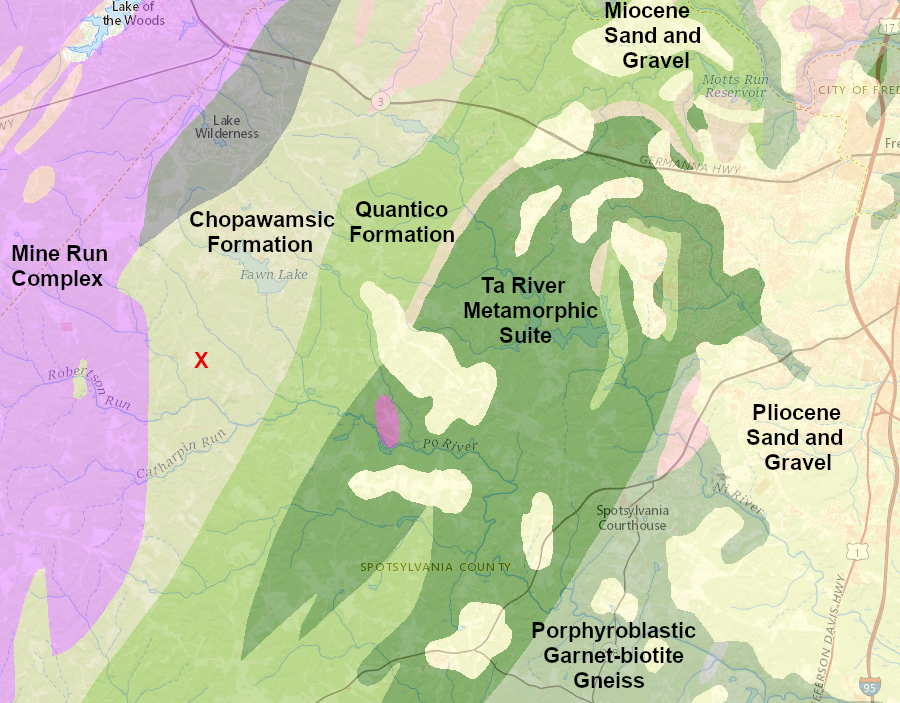
the Whitehall Mine is located in the Chopawamsic Formation, north of Lake Anna
Source: Mindat.org, Whitehall Mines, Gold-Pyrite Belt, Spotsylvania Co., Virginia, USA and ESRI, ArcGIS Online
Mining a gold vein required excavating a high percentage of "waste rock" in order to extract the ore. Veins varied in width, reflecting the size of fractures in which hydrothermal fluids crystallized as well as the percentage of gold in those fluids. When miners reached the end of a vein, they continued to excavate in hopes of finding a new segment nearby:11
The first state geologist for Virginia, William Bartram Rogers, noted:12
Source: Science Museum of Virginia, Lunch Break Science: Gold in Virginia
The ore-bearing quartz extracted from lode mines had to be crushed before chemicals could be used to separate the gold particles attached to quartz crystals. Pulverizing rock required heavy machinery to grind the ore and expose the crystal surfaces where gold had crystalized as hydrothermal fluids cooled. Placer mining which required an individual to use only a bowl or simple equipment that used gravity to separate out gold flakes. In contrast, lode mining was an expensive industrial operation requiring hired workers and capital investment.
The first lode deposit was discovered in Virginia in 1806 at the Whitehall mine in Spotsylvania County. By the mid-1820's, several lode mines were being developed in Amherst County.
Over 300 gold mines were developed in Virginia. Total production since 1804 was approximately 100,000 troy ounces. Peak production was 6,259 troy ounces in 1848, the year gold was discovered in California.
Placer (alluvial) gold was scarce by 1830, so mining shifted to digging quartz/gold veins in bedrock. The lode or "hard rock" mines were excavated in the saprolite in the Piedmont, which was relatively easy to excavate with pick and shovel.
At depth, the bedrock which had not decomposed into saprolite had to be blasted with black powder; dynamite did not become available after the Civil War. The technical challenges and financial costs of pumping water from deep shafts restricted most mining to within 300 feet of the surface. If there is gold ore still cost-effective to mine in Virginia, shafts deeper than 300 feet or large open pit mines will be required to extract it.
Miners used evidence on the surface to identify the presumed location of veins with gold ore that plunged deep into the earth. Shallow pits were used to remove that portion of the vein at the surface, then a vertical shaft was dug to reach the ore deeper underground.
Since veins angled into the ground and shafts were vertical, horizontal levels or "adits" were dug from the shaft to reach the vein and excavate the ore. Typically, veins were narrow and the bedrock was solid enough so the hole or "stope" left when ore was extracted would not collapse. Otherwise, wooden timbers had to be cut, carried underground, and installed in the mine.
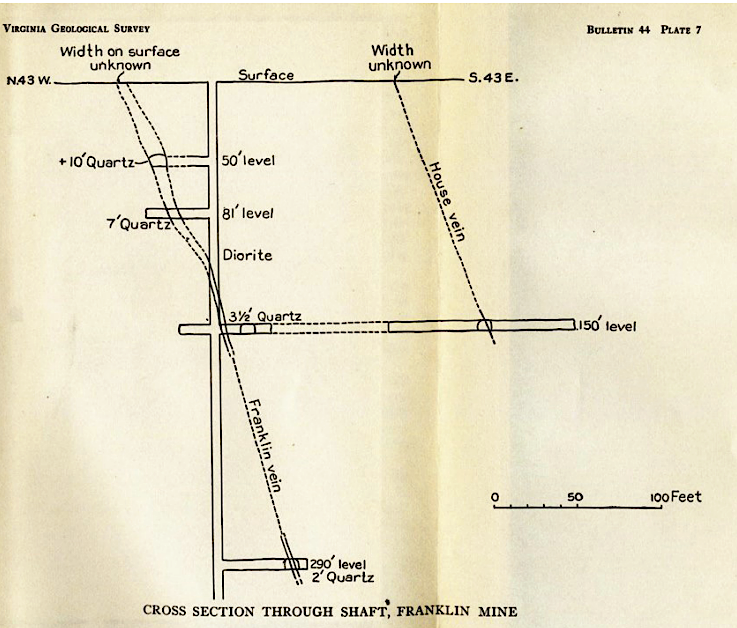
lode mining required digging shafts to intercept the ore-bearing veins at depth
Source: National Academies of Sciences, Engineering, and Medicine, The Potential Impacts of Gold Mining in Virginia (Figure 2-8)
In 1831 the Virginia Mining Company was the first company to be incorporated to mine gold in Virginia. It mined a lode deposit on the Grasty tract in Orange County between 1831-1834. By 1910, five different companies had tried to make a profit extracting gold there.13
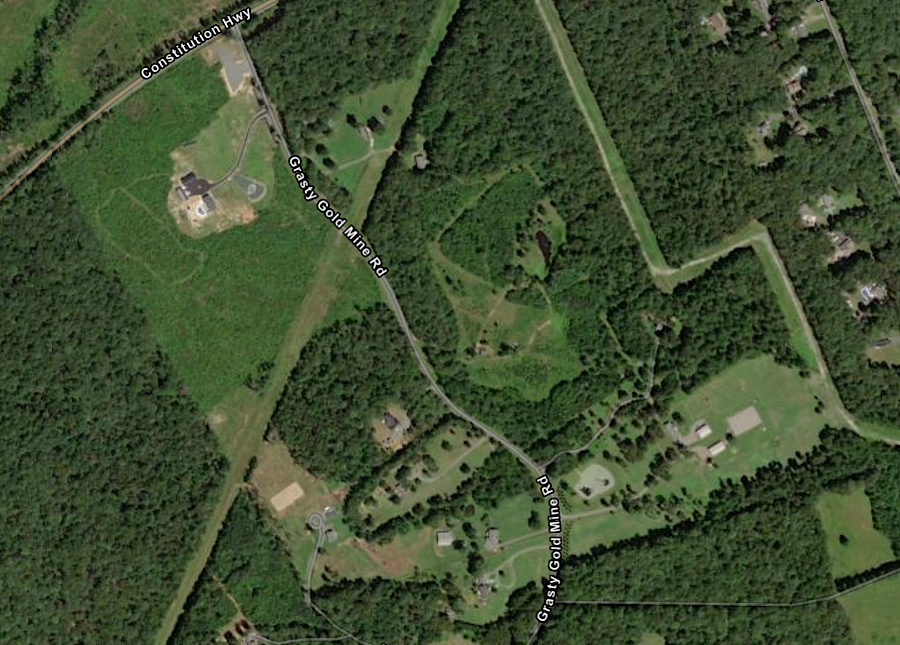
little evidence remains today of the gold mining between 1831-1910 on the Grasty tract in Orange County
Source: ESRI, ArcGIS Online
Gold was discovered in Orange County in 1826, supposedly by children returning from Sunday School. The Orange Grove Mine, near a modern boat ramp on Lake on the Woods, became a major producer.
The Vaucluse Mine nearby, which operated between 1832 and the Civil War and again in the 1930's, became one of the largest source of gold in Virginia. There were steeply dipping veins of ore that averaged 4 feet wide by 50 feet long, stretching in length from a few inches to more than 200 feet.
The gold-pyrite belt was prospected and Franklin Mine in Stafford County opened around 1837.
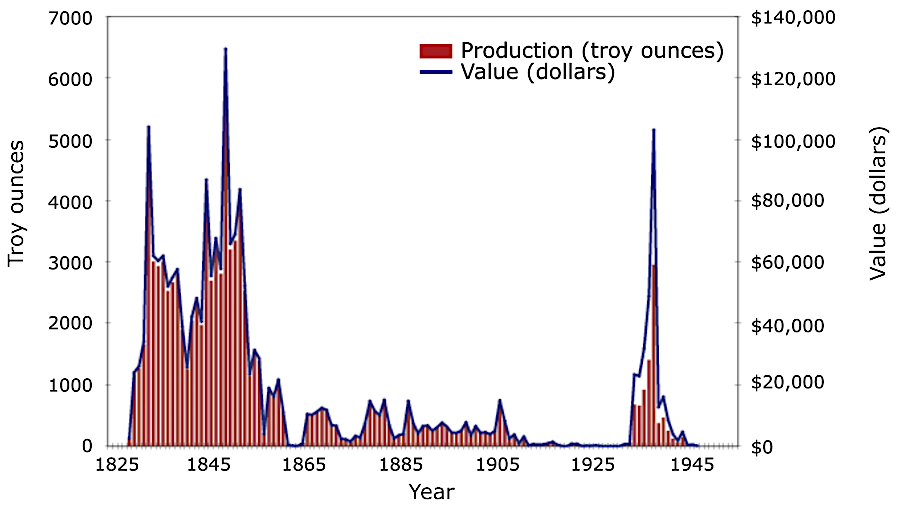
gold mining in Virginia dropped precipitously after gold was discovered in California in 1848
Source: National Academies of Sciences, Engineering, and Medicine, The Potential Impacts of Gold Mining in Virginia (Figure 1-3)
The first gold mine to open in Fauquier County was the Union Gold Mine, near Sumerduck. It started in 1818, and lasted until 1869. The company imported English miners from Cornwall to dig the shaft. Between 1825-1861, the Franklin Gold Mine reportedly produced gold worth $1.2 million. Mining continued at that site into the Great Depression of the 1930's.
Before the Civil War, there were 20 gold mines in Fauquier County. By 1900, there were 14 operating.
The Liberty Mine in Fauquier County opened in 1834. Ore excavated from the lode deposit was crushed by two seven-ton hollow "hornet balls" made of concrete covering an iron mesh frame. The heavy balls, 7 feet high and 20 feet in circumference, crushed ore placed in circular, 7-foot in diameter concrete troughs. A steam engine provided the power for rotating the balls.
The hornet balls (named perhaps for their resemblance to hornet nests, or perhaps from the buzzing sound they made while rotating in the troughs) have been moved about a mile from Liberty Mine on Rock Run. They are now on exhibit at Fauquier County's Monroe Park and the Gold Mining Camp Museum, the only museum in Virginia solely dedicated to the history of gold and gold mining, which opened in 1998 on Route 17 at Goldvein.14
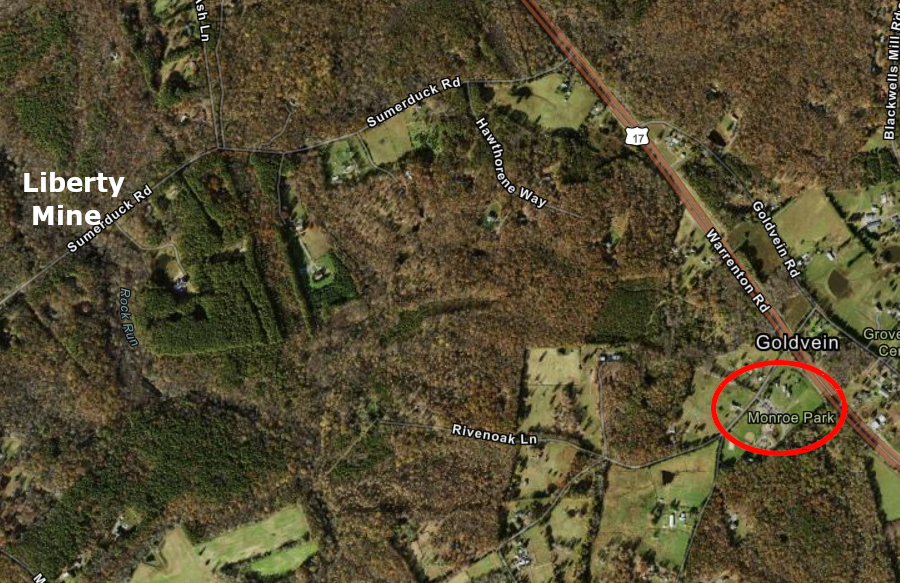
two "hornet balls" used to crush ore were moved from Liberty Mine to the Monroe Park and the Gold Mining Camp Museum in Fauquier County
Source: ESRI, ArcGIS Online
The first stamp mill in Virginia to pound rather than grind the ore was installed in 1836 at the Tellurium mine, the largest of the 50 gold mines that were developed in Goochland County. The stamp mill replaced the original, less-efficient crushing procedures based on how the Spanish had extracted silver in Central and South America since the 1500's:15
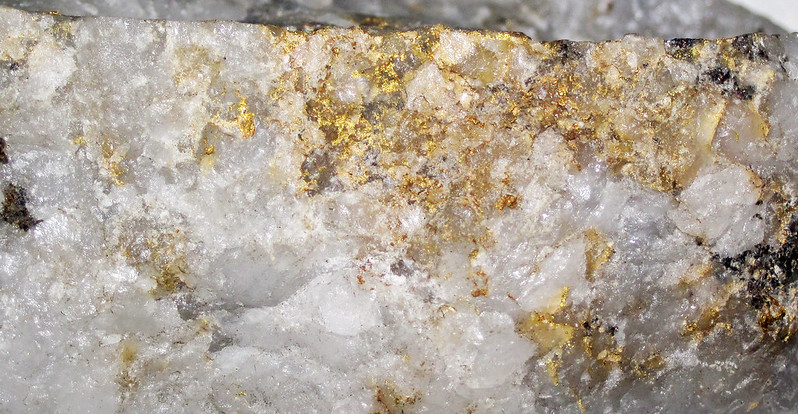
gold and silica (quartz) often crystalized together from hydrothermal fluids to create veins
Source: NASA Goddard Space Flight Center, Quartz-gold hydrothermal vein rock (Neoarchean, 2.67 Ga; Hollinger Mine, Timmins, Ontario, Canada) 4 (by James St. John)
The valuable gold was separated from the non-valuable minerals in the pulverized ore by dissolving it in mercury. The combined gold and mercury "amalgam" was then separated and heated; the mercury boiled off, leaving the gold behind. In the 1830's, the Orange Grove Mine used 250-300 pounds of mercury annually. Mercury was produced from cinnabar ore (HgS) found at the Almaden mine in Spain, and shipped in iron flasks to America.
However, in Virginia's gold-pyrite belt the iron in the bedrock interfered with gold crystals dissolving in the mercury to form an amalgam. As a result, the percentage of gold extracted from the ore was low. On Quantico Creek in Prince William County, the Greenwood gold mine opened upstream of the Cabin Branch pyrite mine in the early 1900's. Two shafts were dug before the mine was abandoned around 1907. Evidently the problem at the site was not so much the pyrite as the lack of a commercial quantity of gold ore.
By cooling the vapor when the mercury-gold amalgam was heated, the mercury could also be recovered and reused. The miners wanted to reduce their processing costs. They were less concerned about the environmental impact of excess mercury, which contaminated local creeks and was converted to poisonous methylmercury in fish.
Today, decades after gold mining has ceased, mercury levels are elevated in creeks downstream from long-closed mining operations. Those who pan for gold as a recreational activity today find tiny balls of mercury and amalgam, as well as flakes of gold. Cyanide was used in the 1920s at the Melville (Rapidan) mine in Orange County to dissolve the gold and then recover it by roasting the amalgam. Unlike elemental mercury, cyanide will degrade over time and will not persist forever in the soil.
When opponents were fighting construction of a Wal-Mart on the Wilderness Battlefield in Spotsylvania County in 2009, they highlighted the risk of contaminated soil being exposed:16
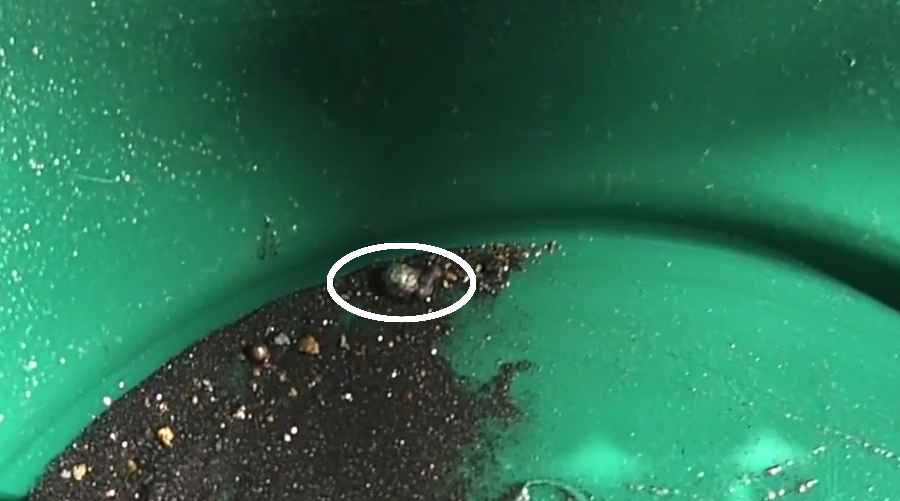
panning for gold today can result in balls of mercury/amalgam as well as flakes of gold
Source: Gigmaster, The Gold Rush In Virginia I
Lake Anna State Park highlights the history of the Goodwin Gold Mine, which was located on Pigeon Run within the park. Interpretive panels identify it as the first gold mine in the state was funded by New York investors in 1832, and that 170 mines operated in the gold-pyrite belt. Between 1830-1850, Virginia was the third-largest gold-producing state. Over 75,000 ounces of gold were transported to the US Mint in Philadelphia.
The Goodwin Mine site was identified after placer mining revealed the site. In placer mining, the heavy gold flakes within stream sediments were separated from quartz sand and clay particle by panning, then by the use of sluices. To reach the ore, the source of the gold flakes, Baltimore investors funded the excavation of a 95-foot vertical shaft in 1881. A steam engine powered a stamp mill that crushed the ore into powder, from which the gold could be removed by amalgamating with mercury.17
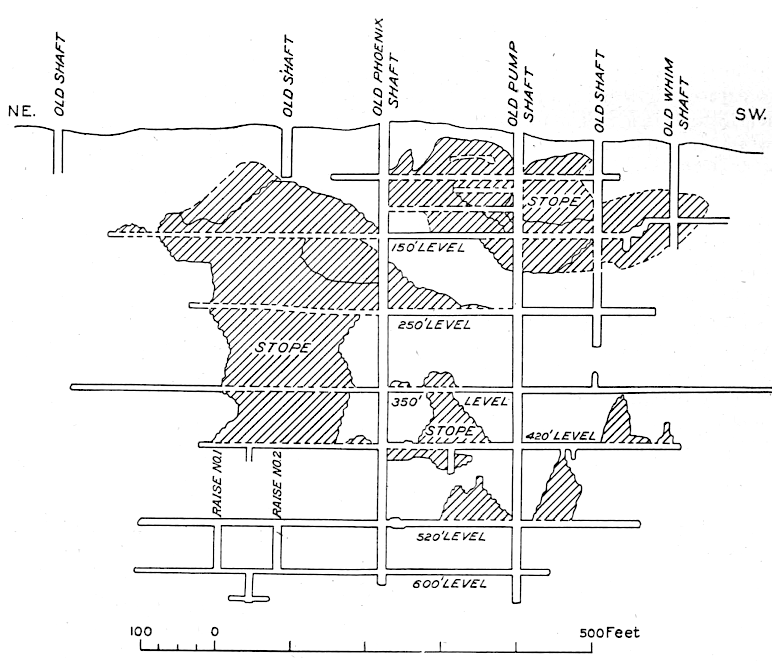
extracting ore from a vein in a lode mine required digging vertical shafts and horizontal levels, such as at the Phoenix Mine in North Carolina
Source: US Geological Survey (USGS), Gold Deposits of the Southern Piedmont (Figure 11)
The name of the community of Goldvein in Fauquier County reveals that it is located within the Gold-Pyrite Belt. There were once 19 gold mines within five miles. The most productive was the Franklin Gold Mine on Deep Run. It opened in 1825, closed during the Civil War, then re-opened in 1868. Between 1877-1901, it was largely dormant due to exhaustion of ore and flooding of the shafts. Mining restarted in 1901, stopped in 1914, and then had one final phase between 1933-1936.
At least one attempt was made in Virginia to use hydraulic placer mining techniques. In 1932, a mining engineer familiar with western and Mexican mining operations leased the tract with the Melville Mine in Orange County. He installed a 4" pipe connecting the Rapidan River to the placer deposits, with a 80-horsepower motor to pump water up to the mining operation. The 4-inch pipe was narrowed by a nozzle to 1-inch, increasing the power of the water to wash sand and gravel free from the stream bank.
Material was eroded from the side of the stream by the power of the water emerging from the hose. Gold particles together with the eroded sediments flowed into boxes with riffles on the bottom, designed to trap the relatively heavy gold particles. The lighter quartz particles, which were of no value to the miners, were expected to flow through the box and form piles of waste tailings.
By the time the hydraulic mining cold begin at the Melville Mine, cold winter weather froze the water pipes. Operations were not started when the weather warmed up; the miner had lost money in the stock market during the continuing Great Depression and could not finance the work alone. He joined with other investors, and the Rapidan Gold Corporation redirected its efforts towards mining the lode deposits via shafts opened to 125 and 240 feet in depth.18
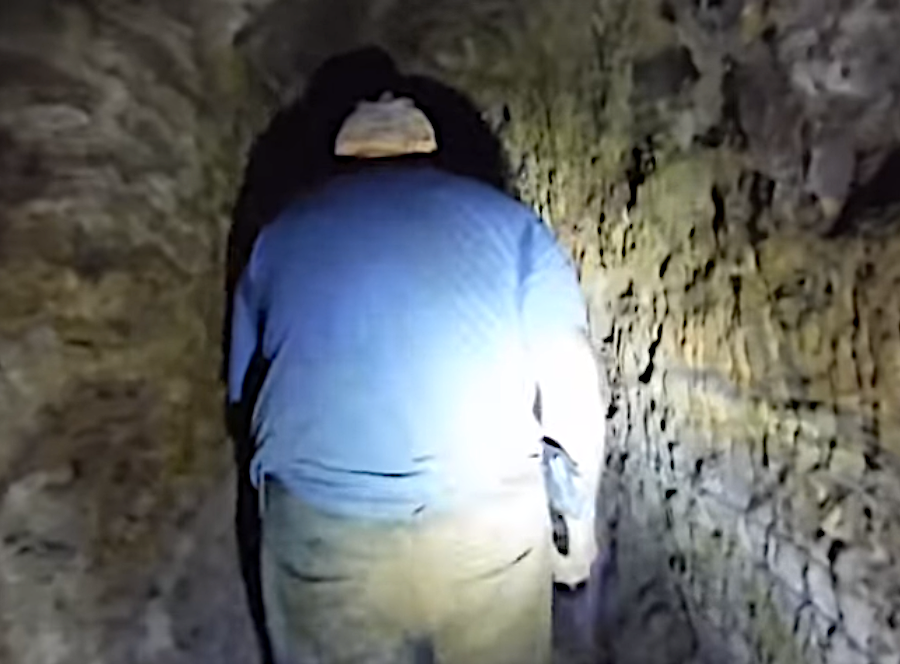
gold miners excavated underground shafts in the gold-pyrite belt east of the Blue Ridge, stretching from Fairfax to Buckingham counties
Source: Gigmaster, Virginia Gold Mine!
Some of the gold mined in California had an unexpected impact on Virginia just prior to the Civil War.
Captain William Lewis Herndon loaded the sidewheel steamer SS Central America on the Atlantic coast of Panama in September, 1857. Along with the passengers, the ship carried nine tons of California gold, including coins from the San Francisco mint. The journey to New York was interrupted by a Category 2 hurricane, and the ship sank 200 miles east of Charleston, South Carolina.
Though 153 were rescued, 425 passengers and crew died. All the gold sank 8,000 feet underwater to the Blake Plateau. In the 1800's, the loss of the Central America was as famous as the sinking of the Titanic is today. The Town of Herndon in Fairfax County honors the captain who heroically tried to offload his passengers before going down with his ship.19

the 1857 sinking of the SS Central America triggered an economic recession (panic) that ended construction of the Manassas Gap Railroad
Source: Wikipedia, SS Central America
The SS Central America shipwreck exacerbated the Panic of 1857, an economic recession triggered by the inability of banks to provide specie (gold/silver) when demanded by the holders of paper bank notes. The economic recession forced the Manassas Gap Railroad to suspend construction of its Independent Line. The "temporary" junction became permanent and evolved into the City of Manassas. The railroad embankment became a key feature on the Civil War battlefield of Second Manassas in August, 1862.20
Three tons of gold from the Central America were recovered in 1988. Treasure hunters discovered where "the bottom was carpeted with gold. Gold everywhere, like a garden..." and brought it back to Norfolk, where many of the people rescued from the ship had come ashore in 1857. Multiple lawsuits over rights to the salvaged gold were resolved in the Eastern District of Virginia court. However, the key person in the treasure hunt was accused of selling $50 million worth of the gold and cheating the investors who had contributed $12.5 million to finance the search and recovery from 7,200 feet underwater. He was jailed in 2014 but refused to talk, and the gold from the S.S. Central America disappeared for a second time.21
Mining of lode deposits dropped off after discovery of gold at Sutter's Mill in California in 1848. Some production resumed in Virginia after the Civil War, but only in small-scale operations. There was a renewal of interest again after the Federal government set the price of gold at $35/ounce in 1934.
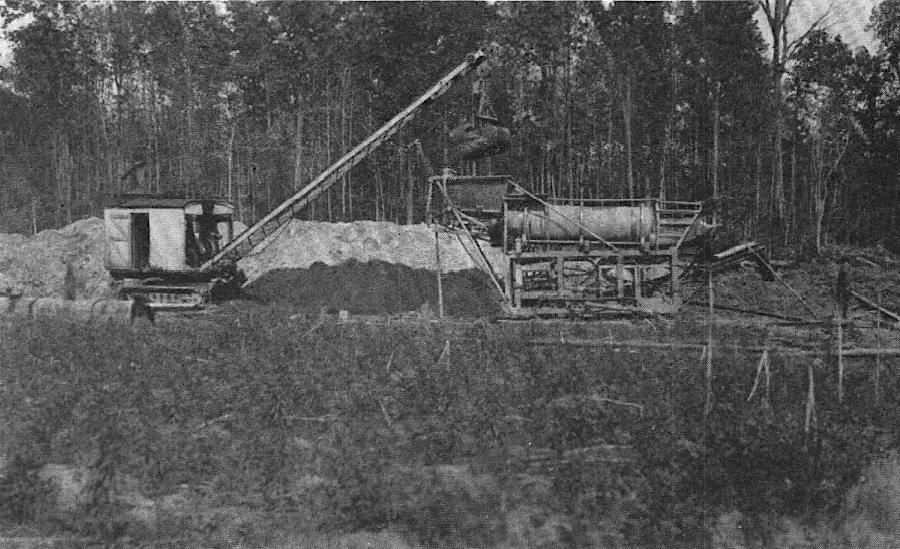
gold mining restarted briefly in the 1930's, including at the Collins Placer in Goochland County
Source: US Geological Survey (USGS), Gold Deposits of the Southern Piedmont (Plate 19)
World War II ended gold mining in Virginia. According to one description, the high price set by the Federal government in 1934:22
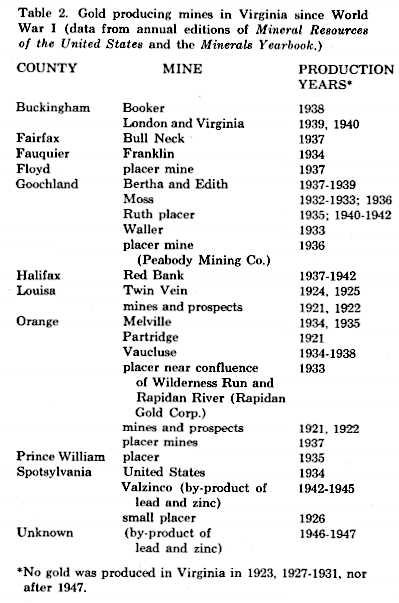
commercial gold mining in Virginia resumed after World War I, but ended soon after World War II
Source: Virginia Department of Conservation and Economic Development, Gold in Virginia (Publication 19, 1980)
There is still gold in Virginia. By one geological estimate, there may be as much as 378,000 troy ounces remaining in lode deposits and 274,000 remaining in placer deposits. However, that gold is not concentrated sufficiently enough in any one location to justify the cost of opening a mine and processing the ore. There is gold dissolved in seawater as well, but the cost of extraction is too high to justify "mining" it.23
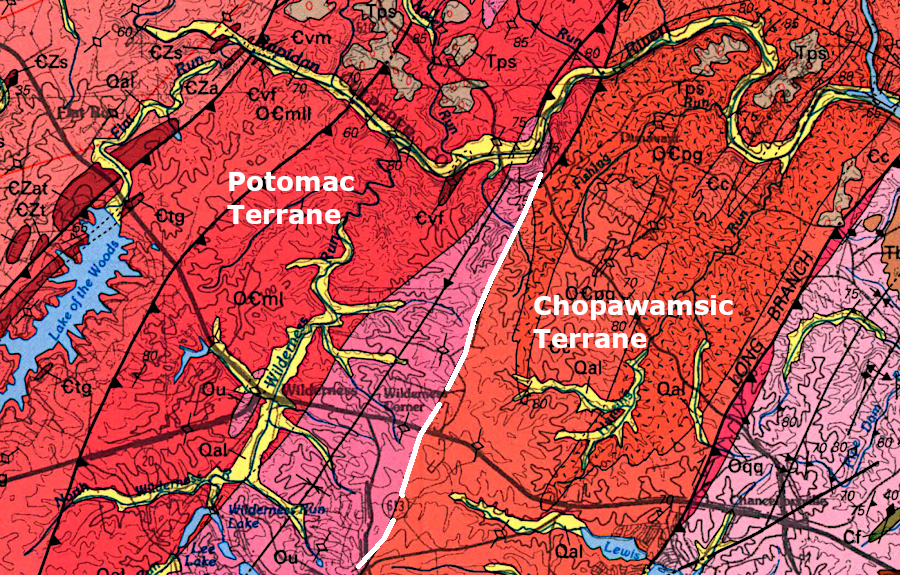
gold deposits in central Virginia are concentrated near the Chopawamsic Fault (white line)
Source: US Geological Survey (USGS), Geologic map of the Fredericksburg 30' x 60' quadrangle, Virginia and Maryland
Exploration and drilling by the Callahan Mining Corporation in the 1970's revealed the extent of the Cofer deposit in Louisa County, between Mineral and Wares Crossroads. There was gold, but not concentrated enough in the ore for the deposit to be economic to mine. The site was reclaimed after 2008. Two shafts were closed; tailings were covered in lime and topsoil before being replanted. Primary benefit of reclamation was the elimination of acid mine drainage flowing into Contrary Creek.
The Virginia Department of Mines, Minerals and Energy (now Virginia Energy) sought Abandoned Mine Lands funding for the cleanup. The site history notes:24
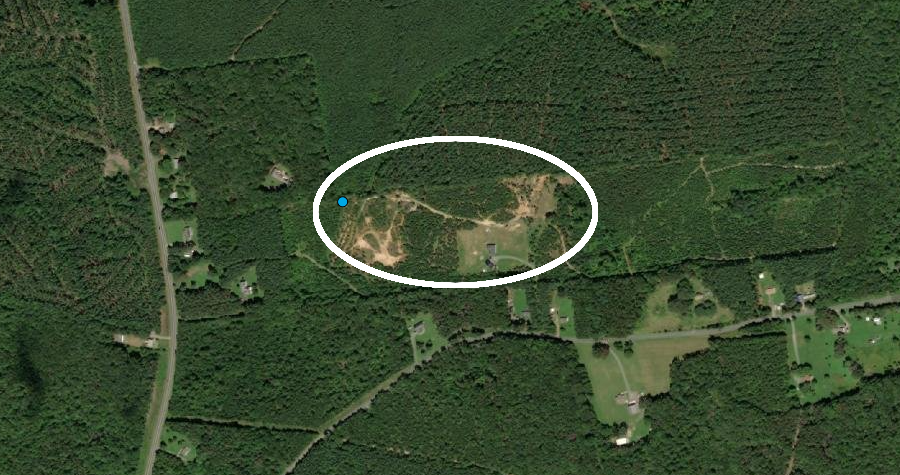
the Cofer deposit in Louisa County was a new gold mining prospect in the 1970's, but the site was reclaimed 30 years later
Source: Virginia Department of Mines, Minerals and Energy (DMME), Mineral Mining
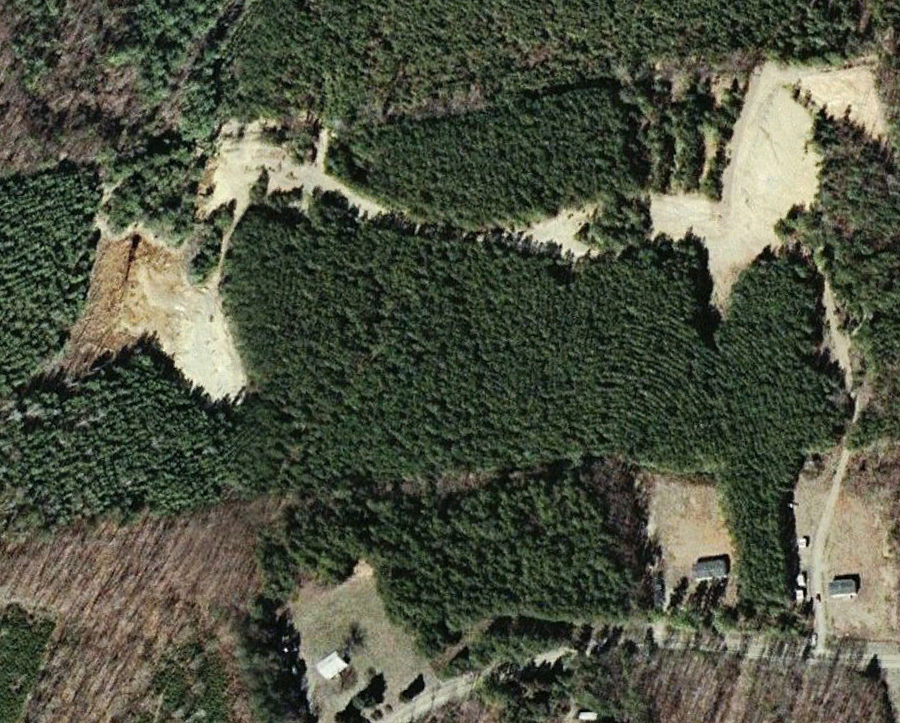
the Cofer deposit in 2002, before reclamation
Source: Google Earth
In 1988, Sterling Exploration requested the Orange County Planning Commission to grant permission for exploratory mining north of Lake of the Woods. The residents in the Lake of the Woods development opposed the possibility that mining could re-start near them. Orange County officials initially rejected the request.25
In 2014, the Board of County Supervisors in Goochland County approved a proposal to re-open the Moss Mine, which had been discovered by John Moss in 1835. It had operated between 1836-38. Two inclined shafts were excavated then, with one stopping 30 feet deep and the other at 50 feet. At the 30' depth, they were connected by a 70 foot long horizontal "drift" excavated through the ore body.
The Moss Mine had been reopened in 1891, with shafts excavated to 70 feet deep and connected another drift at that depth. Before operations stopped in 1933, the mine had reached 230 feet deep. It was reopened briefly in 1936, with a ball mill for crushing ore. Efforts to reopen again in 1984 did not lead to any production.
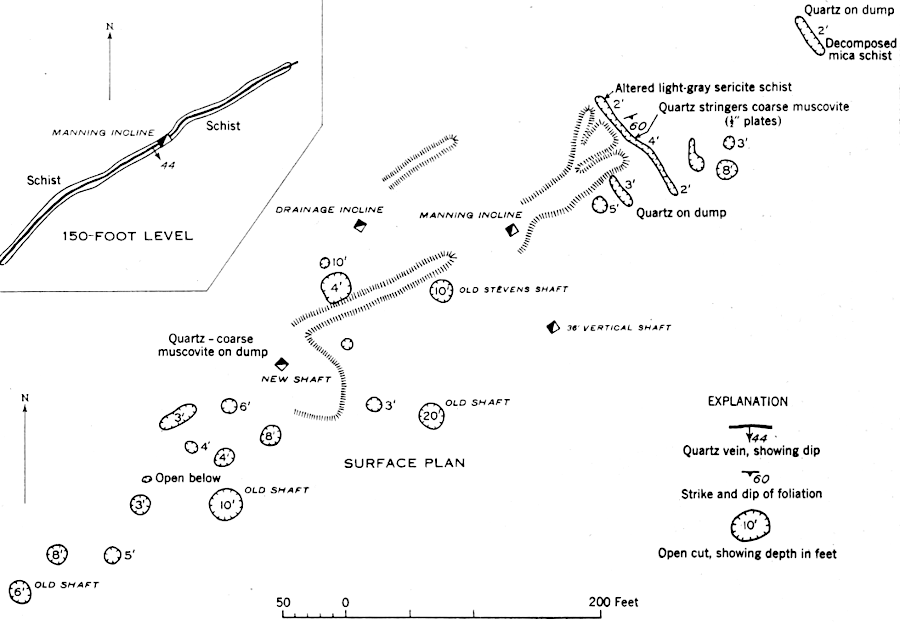
surface plan and 150-foot level of the Moss mine in 1934
Source: US Geological Survey (USGS), Gold Deposits of the Southern Piedmont (Figure 8)
The 2014 proposal was to develop a shallow open pit mine the size of a football field, following a 2-wide gold vein that extended down to 125 feet in depth. Gold would be obtained by "free milling," using water and gravity to physically separate the gold from worthless quartz and other materials without use of cyanide, mercury, or other chemicals.
The applicant described the project as a mine clean-up project, and even suggested he might obtain government funding for site reclamation. The soil was contaminated with mercury which had been used in the past to amalgamate the gold particles in the crushed ore.
Extracting the gold was expected to take just three years. Afterwards, the waste rock would be replaced in the pit, the site would be reclaimed, and a wetland created. The projected $2 million cost for mining would be offset by the gold that would be extracted, but at a minimum the property would be more marketable after removal of the mercury.26
In 2021, the Moss Mine at 4385 Shannon Hill Road in Goochland County was the only site in Virginia with a state-issued permit for reclamation after mining gold. The permit was held by Big Dawg Resources LLC, which posted a bond for $3,000 per disturbed acre to cover potential cleanup costs. That bond amount, set by the Virginia Department of Energy, was far below the estimated cost of $8,000-$12,000 per acre for actual reclamation.
Big Dawg Resources LLC also obtained a local permit for gold mining operations. In 2020 the Goochland County Board of Supervisors renewed the Conditional Use Permit issued in 2014, which had expired after five years. According to the staff report from Goochland County staff, the proposed mine plan changed in the new permit:27
The Virginia Department of Environmental Quality (DEQ) would not limit the use of mercury or cyanide for the extraction of gold at the Moss Mine, but would impose limits on what might be released from the site. An official from the state agency stated:28
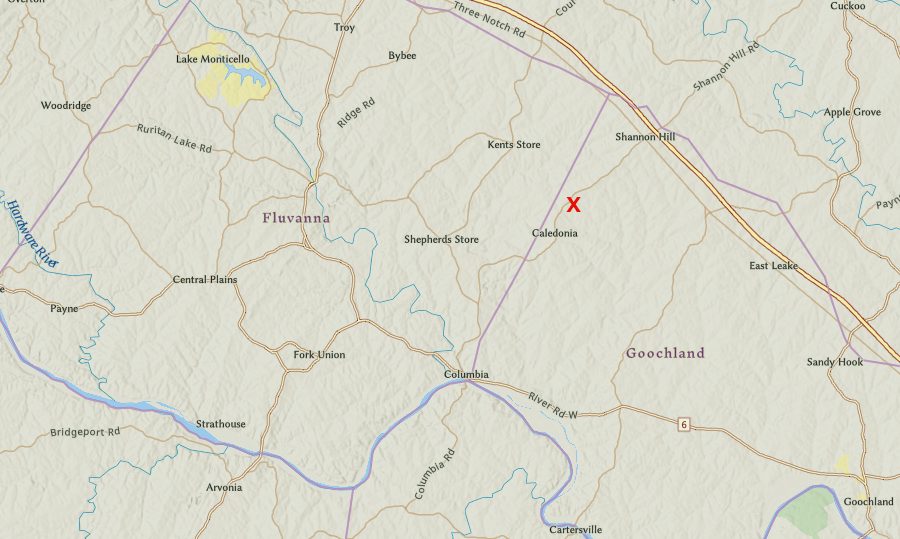
in 2014, Goochland County officials approved re-opening the historic Moss Mine (red X) for gold mining
Source: ESRI, ArcGIS Online
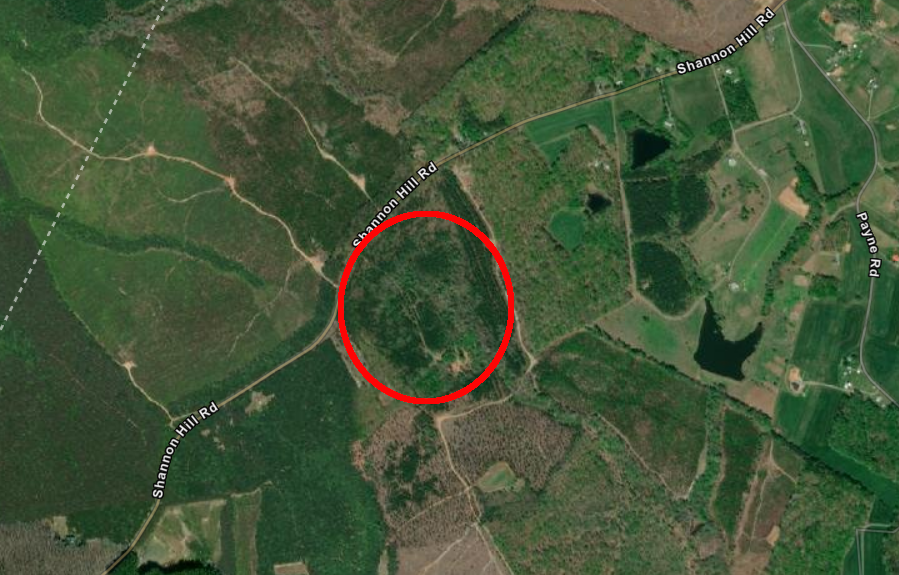
the site of the historic Moss Mine may be more valuable for residential and timber use, rather than gold mining
Source: ESRI, ArcGIS Online
The 2023 study by the National Academies on gold mining in Virginia reported that the Moss Mine was successfully reprocessing historically mined materials on a 1-acre site to extract gold. Mercury which had already amalgamated with the gold was being captured and shipped to another location for further processing. Material sorted by the Moss Mine equipment was replaced on the site, after the mercury-containing component had been removed. However, the volume of material being processed was minimal.29
A new gold deposit was discovered in Buckingham County, west of known deposits in the Chopawamsic Terrane, after stream samples were analyzed. In 2020, Buckingham County residents expressed concerns that drilling of over 20 exploratory holes since 2016 could lead to open-pit gold mining. County officials notified Aston Bay Holdings that its core sampling for commercial use was not a permitted "by-right" activity in areas zoned for agricultural use.
The company had leased 5,000 acres in the county, plus another 6,000 acres in Central Virginia. Aston Bay claimed to have found 701 grams of gold per ton in samples from the surface, and up to 37 grams per ton in drill cores that sampled the underground vein. However, the company's finances were questionable. Its shares were a "penny stock," and Aston Bay had no history of actual mining. Two other exploratory drilling projects in Buckingham County since 1980 had failed to lead to actual mining.
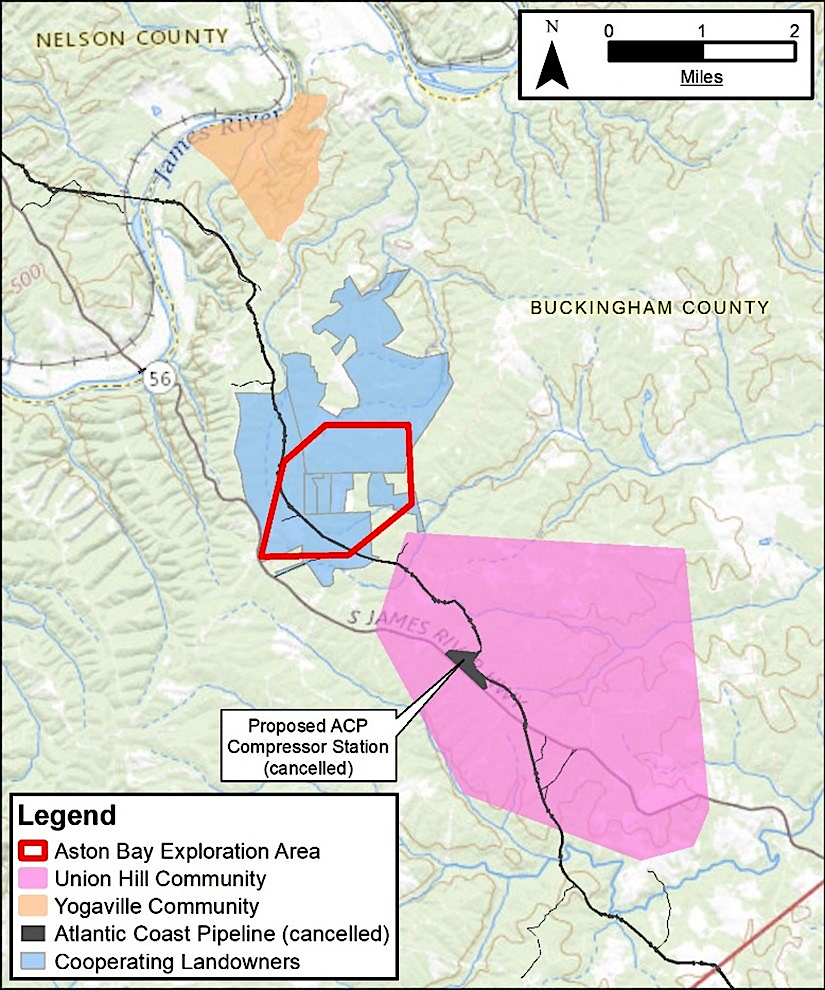
Aston Bay Holdings began exploratory drilling in Buckingham County in 2016
Source: Allegheny-Blue Ridge Alliance, Proposed Gold Mine Could Threaten Buckingham County, James River
The Friends of Buckingham expressed concerns that exposure of copper, lead, and zinc sulfide minerals and mining operations could lead to surface water contamination, and potentially groundwater impacts on drinking water wells. To minimize such risks, the Virginia Department of Mines, Minerals and Energy (renamed the Virginia Department of Energy in 2021) had reclaimed three old mining sites in 1997. Tailings were removed and/or covered at the London-Virginia, Buckingham, and Sprouses Corner gold mines.
Aston Bay Holdings anticipated using modern mining techniques and gold extraction technology to make it profitable to restart gold mining in Buckingham County. That approach had been successful in South Carolina, where the Haile gold deposit discovered in 1827 had been re-developed after 2007 to become the largest gold mining operation on the East Coast. In Central Virginia, the target was:30
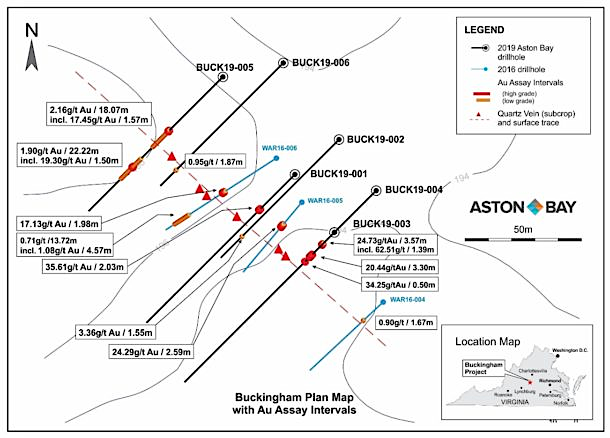
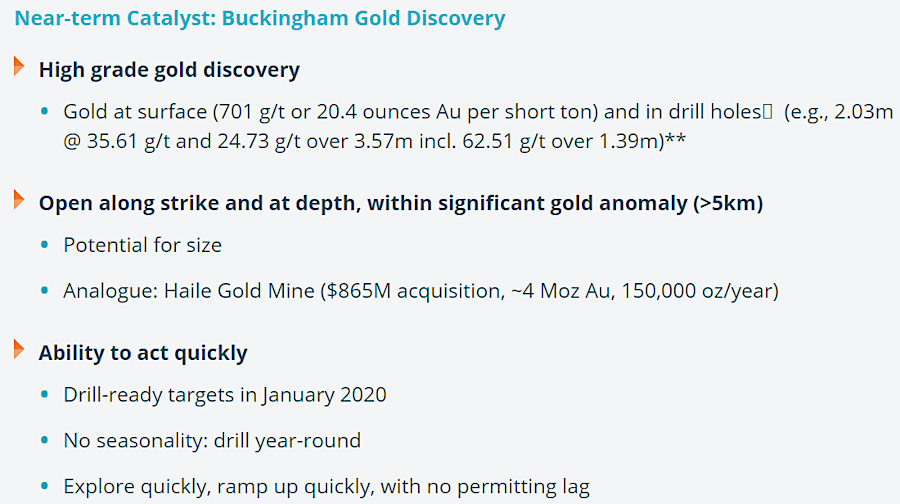
Aston Bay advertised the potential in Buckingham County because it needed to attract capital for actual mining - or stock speculation
Source: Aston Bay, Virginia Overview and Buckingham Gold Property
The 2021 General Assembly declined to impose a temporary ban on mining gold in Buckingham County, but did require the Virginia Department of Energy to study the impacts of developing the deposit and provide a report to the legislature by the end of 2022. The state agency contracted with the National Academies of Sciences, Engineering and Medicine to conduct an independent study to:31
The Chief Executive Officer (CEO) of Ashton Bay Holdings made clear that all mining would be done in underground workings. Underground mining might impact groundwater in ways similar to underground coal mining. Underground tunnels would not create the risks of a large excavation with a massive pile of tailings piled on the surface, which could be carried in a flood into nearby streams used as sources of drinking water.
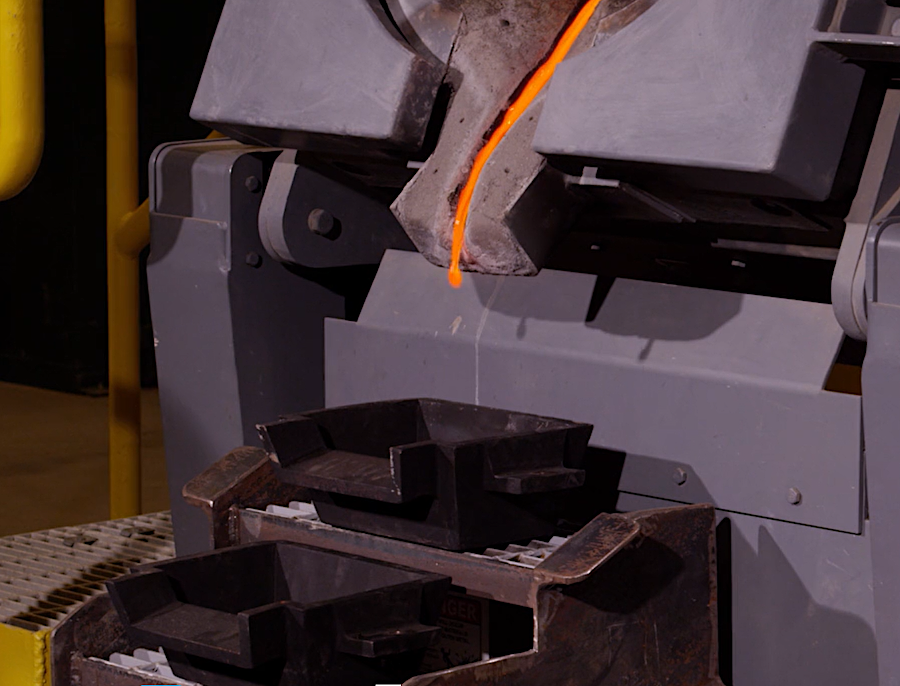
first pour in 2017 of gold extracted from the re-opened Haile gold deposit in South Carolina
Source: OceanaGold Corporation, HGM Gold Pour Master
In 2021, Ashton Bay Holdings also started exploratory drilling for copper and zinc on about 2,000 acres in Pittsylvania County. In discussion of the potential reclamation costs for a mine, a Virginia Department of Energy official noted that mining companies had to post a bond of $3,000 per disturbed acre while actual cleanup costs would be $8,000 to $12,000 per acre.
The company said it had identified an almost-vertical gold vein that was 200 meters long, 1-2 meters wide, and extending at least 100 meters deep. The total amount of available gold identified by Ashton Bay Holdings did not attract investors willing to fund the excavation and processing costs. An Ashton Bay Holdings official suggested the company could use underground mining to extract the valuable mineral:32
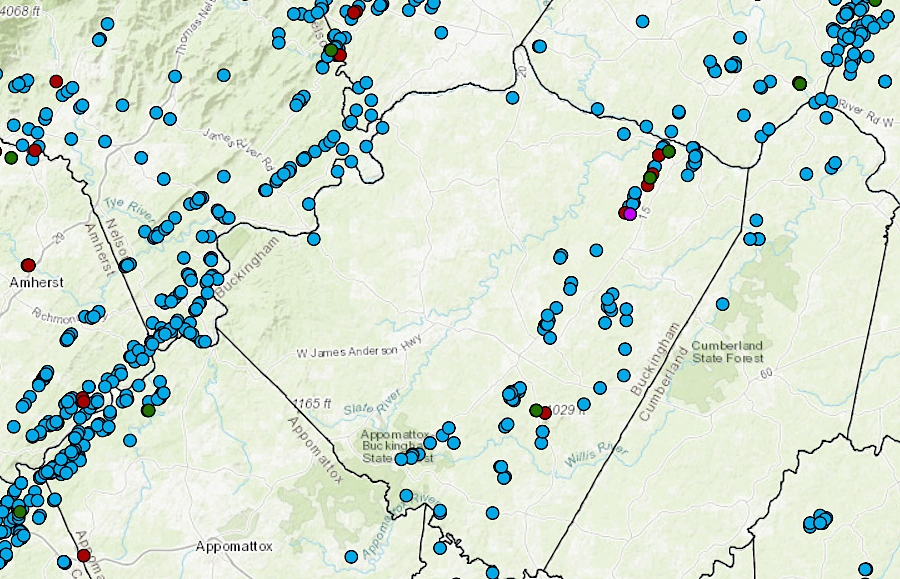
active and abandoned mines and quarries in Buckingham County in 2021
Source: Virginia Department of Energy, Mineral Mining
No mining was proposed in Orange County in 2021, but the historical gold mines became involved in the controversy over the proposed Wilderness Crossing rezoning to build 4,750 residential units on 2,168 acres. There were five historical mines on the proposed site with 15 shafts and surface mines; all had been dormant since the 1930's.
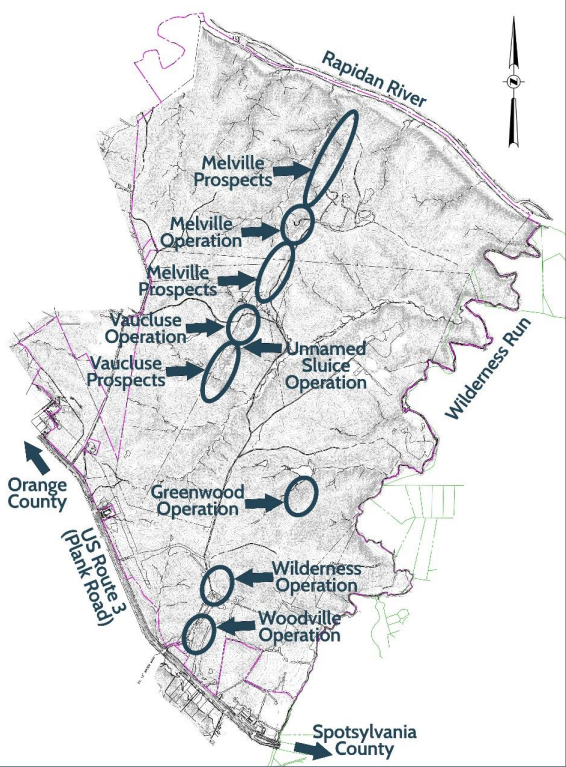
there are five known and named mine locations within the Wilderness Crossing Project
Source: Sullivan, Donahoe & Ingalls (SDI), Outline of Approach Strategy and Update on Gold Mine Coordination, Wilderness Crossing Development
The Vaucluse mine, where more gold was mined than anywhere else in Virginia with almost 1,000 feet of horizontal shafts, was in the center of the project site.
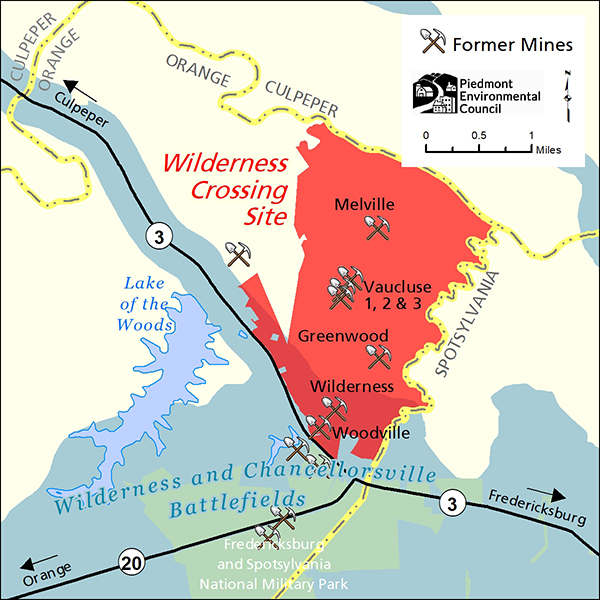
sites of former gold mines were within the Wilderness Crossing proposal
Source: Piedmont Environmental Council, Shocking news about historic gold mining contamination
Opponents of the project highlighted how gold mines had used mercury, and the Rapidan River was currently "impaired" because of mercury in fish tissue. However, the source of the current mercury could be upwind coal-burning power plants. Burning the fuel in the 1900's and early 2000's vaporized mercury within the coal, and emissions from power plants moved via air currents that reached Virginia where rain deposited the pollutant.
The Wilderness Crossing rezoning proposal did not include mitigation or remediation measures for historic mines, but acknowledged the local history with place names such as Goldmine Parkway.33
At the end of 2022, the National Academies of Sciences, Engineering and Medicine report concluded that Virginia's bonding requirements and other regulations were inadequate:34
Recreational gold mining, panning for flakes in streams, is legal where landowners have authorized access. Streams flowing out of the 20,000-acre Appomattox-Buckingham State Forest may offer the best opportunity for finding flakes. Virginia State Parks advertises occasional gold panning programs at Lake Anna State Park, and the Central Virginia Gold Prospectors club provides guidance to members.35
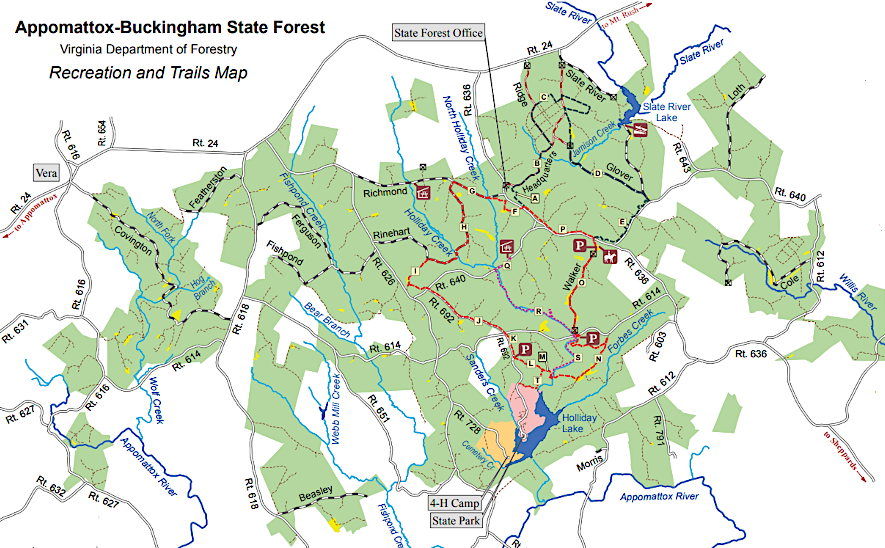
gold panning has relatively high potential in streams flowing out of Appomattox-Buckingham State Forest
Source: Virginia Department of Forestry, Geologic map of the Fredericksburg 30' x 60' quadrangle, Virginia and Maryland
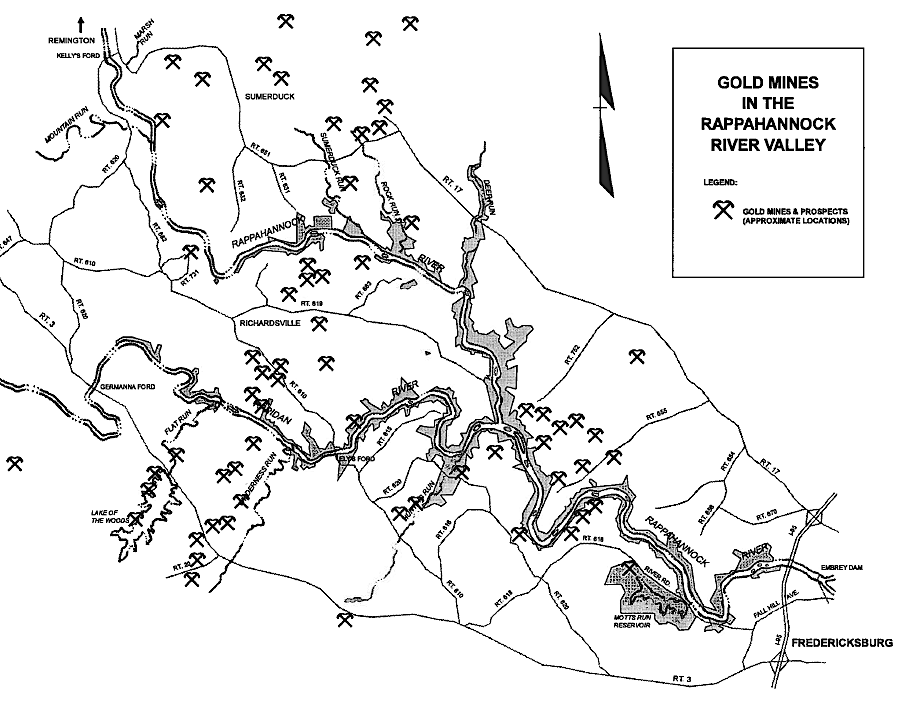
gold veins are concentrated in the Piedmont, in the Potomac and Chopawamsic terranes accreted onto the North American Plate in the Taconic and Neo-Acadian orogenies
Source: City of Fredericksburg, Historic Resources Along The Rappahannock And Rapidan Rivers (p.46)
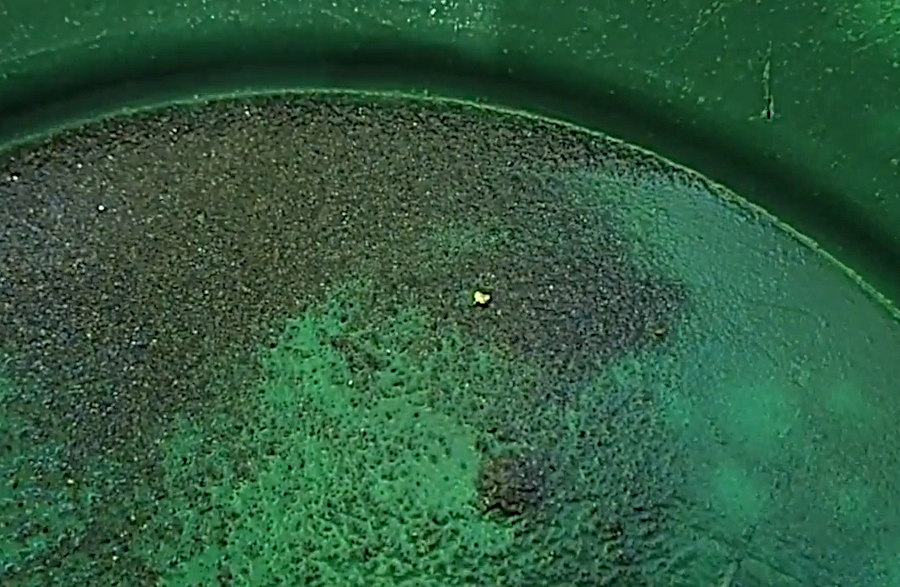
panning for gold in the Piedmont will result in one or more flakes, but is a recreational rather than commercial activity today
Source: Gigmaster, The Gold Rush In Virginia I